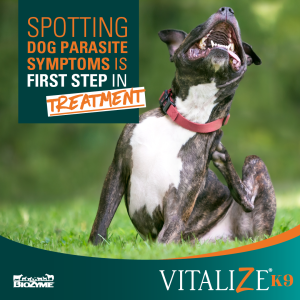
8-week-old Puppy
It’s said that dogs are man’s best friends. Well, puppies can be everybody’s best friends. The tail wagging and sloppy kisses are good signs that your puppy is getting adjusted to his or her new home, and that is likely taking place right around the time that little fluff ball turns 8-weeks-old.
Just like a child, an 8-week-old puppy doesn’t come with an instruction manual. At BioZyme®, makers of Vitalize®, we love all animals, especially puppies. So, we wanted to provide a checklist of how to care for your growing canine friend.
We’ve already covered tips for your new puppy, so let’s take a look at that next fun stage of life!
The Adolescent Phase
It’s said that puppies between 8-10 weeks old begin their adolescent stage. Think about the socialization skills that take place for humans during this phase. Awkward. And that is likely how your puppy will be, too. One minute it might be clingy as ever; the next it will want to explore new territory.
It is important to start training your puppy at this age, but remember, it is an adolescent, so it is probably going to have selective memory and hearing. Puppy training takes lots of patience, love and positive reinforcement.
Training your Puppy
An 8-week-old puppy might not be the best listener, but it is important to start the training process early. There are several training types you will want to consider when they are about 8-weeks-old.
Behavior Training
Even at a young age, you can start with the basic commands of sit, stay and come. It is important to use their name as often as you can and look at them when you are talking to them. For instance, you would want to say, “Sit, Roxie,” with a hand signal of your palm above her head, if you wanted your puppy, Roxie to sit. Once she sits, reward her with kind words, like “good girl,” an ear rub, and a small treat.
Socialization
This adolescent phase can be a two-way street for an 8-week-old puppy. They can either be very fearful or full of curiosity or both. While they are young is a great time to socialize with them to acquaint them with other people and objects in your house. Don’t crate or kennel them when you have guests unless special circumstances require it.
Introduce them to knew people and teach them not to jump. Let them sniff new and unfamiliar objects like wheelchairs, furniture or baby strollers so they are not afraid of them and don’t bark at them.
Independence
Just like your pup needs to learn to be around unfamiliar people and objects, it also needs to learn to be weaned from you, it’s puppy parent. Separation is hard, but unless you never leave your house, you need to teach your little canine companion to be on its own. This is a great time to teach crate training. Dogs actually appreciate having their own space, like a crate where they can feel safe and protected.
Put their crate in a quiet, safe, climate-controlled area, with a soft blanket or dog bed inside of it. You can feed your dog at one end of the crate, if there is room, making it more desirable for it to go to the crate or kennel.
To get it to enter the crate, select a word like “home” or “kennel” and point to the opening. Once your puppy enters, reward it with positive words and a small treat. You might want to set with it for a few minutes, but then leave the room to give it some alone time.
When To Kennel
It’s best to crate or kennel your dog whenever you leave the house for an extended amount of time and at bedtime. That way your puppy feels secure and comfortable in its own little space, and it will become accustomed to going in the crate since it will be known as a safe space.
Finally, crate training will help you housebreak your puppy. If you let your puppy outside each time you let it out of its crate and command it to “potty,” it will learn that it has a very specific job after leaving the crate.
Animals will not typically have accidents in confined areas, so the crate is a great place to keep them while teaching them the appropriate times and places. When they are so little, be sure this happens every 2-3 hours, as their little bladders are not very big.
Low-stress Handling
It is important to teach your puppy to be handled gentled. This includes rubbing its tail, belly, ears and legs. Start this slowly at about 8-weeks-old, so they will be used to the veterinarian handling them at check-up time. If they don’t like one part of their body rubbed, like their tail, move to another part and come back.
Give Them a Routine
Just like any little one, routine for your 8-week-old puppy is very important. For a while it might look something like this: eat, sleep, potty, play, potty, eat, sleep, potty, repeat. And that is okay. They are growing, which requires a lot of sleeping and eating. But in between, they also need some playtime.
Just like humans, pups need both physical and mental exercise. That is why it is important to add play time to their routine. This can include going on walks, playing fetch or giving them other chew toys to play with. Remember, puppies are still learning their manners, so if you don’t want them to chew on socks or shoes, don’t play fetch with socks or shoes. Be mindful that the toys you do play with are actual toys.
At 8 weeks old, puppies are also still losing their baby teeth and growing their adult teeth. Be sure to provide them with things that are not harder than what you can place your thumbnail print into. Damaging a baby tooth can lead to further dental problems later in life.
Take care of their Health
Make sure you talk to your puppy’s breeder to find out what vaccinations it received before you pick it up and follow up with any necessary boosters. At this age, puppies require several vaccinations to keep healthy.
Establishing a relationship with your new pup and your veterinarian will help your veterinarian become acquainted with your animal and know what to look for should it start experiencing any symptoms of illness. It is also important for your pet to understand that the vet is a caring person, and not a scary place to visit.
Provide Quality Nutrition
An 8-week-old puppy will already be weaned from milk and eating 3 to 4 meals per day. Feed it a fortified puppy food that is easily digestible and the right size for it to chew.
Because your pup has just experienced stress, like weaning and adjusting to new surroundings, Vitalize offers products that leave an undeniable impact.
Check out these products that can specifically help with the post-weaning stress and immune response:
Dog Gel
Vitalize® Dog Gel is a prebiotic and nutrient-rich gel for dogs designed to give immediate support to the digestive and immune systems. It contains AO-Biotics® Amaferm®, a prebiotic research-proven to enhance digestibility and MOS, which helps normalize gut microflora and supports the immune system. This fast-acting product supports appetite and hydration.
Alimend K9
Vitalize® Alimend® K9 is a liquid product for dogs designed to support gastric health and GI tissue and which may relieve occasional gastric issues. It also contains Amaferm, and it also contains MHB3®, a patented high molecular weight hyaluronic acid that coats the stomach and supports GI tissue integrity. Additionally, it includes beta-glucans that support the gut and immune system.
Vitalize Trixsyn Canine
Vitalize® Trixsyn® Canine is a liquid product for dogs designed to support joint health using hyaluronic acid. It contains MHB3, a patented high molecular weight hyaluronic acid.
It is never too early to start supporting hip and joint health and mobility. Puppies grow fast, and with Trixsyn with MHB3, you can prevent joint problems before they begin. Oral administration of MHB3 Hyaluronan assists in healthy bone formation and supports the maintenance of bone mineral density.
Learn More about Vitalize
There are more Vitalize products available for your 8-week-old puppy for both gut and joint health. Learn more about Vitalize and taking care of your puppy as it grows.
Want to purchase Vitalize for your new puppy? You can shop online. Or if you prefer to shop locally, you can find a retailer on our dealer locator.

